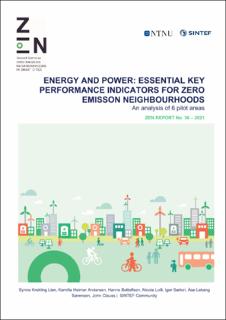| dc.description.abstract | The development of the definition, assessment criteria and key performance indicators of Zero Emission Neighbourhoods (ZEN), is an ongoing process that will last throughout the program period of FME ZEN. This work will enable an assessment of the performance of the ZEN pilot areas. Based on the draft for the ZEN definition, the KPIs for ZENs can be divided into the following categories: GHG Emissions, Energy, Power, Mobility, Spatial qualities, economy and innovation.
The scope of this report is to test the suggested KPIs for Energy and Power on six different pilot areas. The purpose is to evaluate the KPIs when used on different pilot areas in different development stages. The selected pilot areas (cases) are Ydalir, Oksenøya (Fornebu), Zero Village Bergen, Dolvik, Campus Evenstad and Mære landbruksskole. Two of these pilots (Evenstad and Mære) have local heating systems, while the others are connected to a district heating network. In the report, the KPIs are calculated for each of the pilots as they are planned (the ZEN scenario) and in 1-2 representative reference scenarios which represent the pilots in a business as usual case.
The testing of the KPIs for Energy and Power shows that the pilots get different results in the ZEN scenarios compared to the reference scenarios. The energy savings in net energy demand is only estimated to be between 8-32 %. This KPI has only been estimated for new areas, and the reduction in net energy demand is small in the ZEN scenario, due to the reference buildings already being rather efficient. The electricity savings is estimated to be significantly higher; the net delivered electricity is expected to be reduced between 28 – 58 % in the ZEN scenario (compared to the reference case with district heating) due to efficiency measures and local electricity production. When compared to a reference case with electric heating, the reduction becomes even larger, at 66 % – 78 %, due to efficiency, local electricity production and the transition from electric heating to non-electric heating (district heating and bio based local heating). The testing also show some potential for large reduction in the peak load (peak import), as a consequence of both more energy efficiency and reduced net delivered electricity, up to 63 – 83 % compared to the the reference case with electric heating. On the other hand, the peak export of electricity may become larger, up to 3 times (300%) of the peak import in the pilots where large areas of PV panels are planned (ZVB and Dolviken).
The case studies suggest that when the KPIs are estimated through the means of simulations (for pilots in the planning phase), the methodology and simulation programs used may have an effect on the results. When a pilot is in the operational phase, measurements should be used for KPI calculations as far as possible. Using measurements for the KPI calculations are linked to several challenges as obtaining measurement data is often time consuming, and there is usually missing data points and few, disorganized meters available. The KPIs seem to perform the main role of providing a way to quantify and grasp the main features of a complex reality where different solutions/technologies might have conflicting effects. The process of working with the KPI calculations show that a professional with competence in energy use measurements and calculations is needed to calculate the KPIs for the pilots, and that there is a need for a standardized tool with a simple interface and standardized methods to simplify this process. There is still a need for further work on system boundaries, definition of the reference scenario, and finding standard methodologies. The results of the study will be used in further work to establish threshold values for evaluating the pilots against the ZEN definition.
Involved ZEN-partners in this study have been SINTEF, Elverum vekst, Elverum kommune, Bærum kommune, ByBo, Bergen kommune, Steinkjær kommune and Statsbygg. | en_US |
